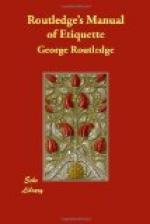nor should it be disfigured by being surmounted by
a kind of cushion or roll of hair which gives the idea
of weight and size. Nor should the hair have the
appearance of a bird’s nest, and look tumbled
and untidy. This was lately the “beau ideal”
of a well dressed head. It was desired that it
should appear unkempt and uncombed, as if it had been
drawn through a quickset hedge. The back of the
head, if well shaped, has a beautiful appearance,
reminding one of a stag, which is so graceful in look
and motion. But when it is disfigured by a large
mass of hair, resembling a large pin-cushion, all
that peculiar native grace which we so much admire
is lost sight of. When all heads are made to look
alike and equally large, there is no advantage in
having a small and well shaped head. It seems
as if the study of the present day were to make the
head look large, and to conceal all its points.
We miss the smooth braids of hair which set off the
expanse of forehead, and the coils of plaits of hair,
which ornamented, but did not conceal the back of the
head. We miss the glossy look of the hair which
indicated care, and prefer it infinitely to that which
simulates neglect. It is perfectly true that
one style does not suit all persons alike, any more
than that the powder which was worn by our great-grandmothers
was equally becoming to all. A low forehead,
if the points of the brow are good, should have the
hair drawn off it, whereas a high forehead which does
not betoken any great intellectual power is disfigured
by the same process. Smooth braids will not become
a long face, nor puffs a broad one. A forehead
which is already too high cannot bear to be heightened
by coronets and cushions of hair, nor a countenance
which indicates weakness to be made weaker still by
limp luxurious curls. A stern face requires to
be softened, while a weak one requires strength.
The hair can generally do this. It depends upon
how it is dressed.
They who are no longer young endeavour to impose upon
the world by the use of wigs and fronts. These
are an abomination, and in every instance they are
easy of detection. There is something in the way
in which false hair protests against the face and
the face against it, which infallibly exposes it to
be false. A lady with all the signs of years
about her face makes her age the more apparent by the
contrast of glossy dark hair which belongs to youth.
Why is she afraid to wear her own grey hair?
Grey hairs are no reproof, and we are quite sure they
would harmonize better with the other marks of age
than the wigs and fronts which prevail. There
is something in the white hair of age which has a
charm of its own. It is like the soft and mellow
light of sunset. But unfortunately an old woman
is not always inclined to accept the fact that she
is old. She would rebel against it, but rebellion
is useless. The fact remains the same. She
is old notwithstanding her “rouge” pot
and her front, and she is growing older day by day.




